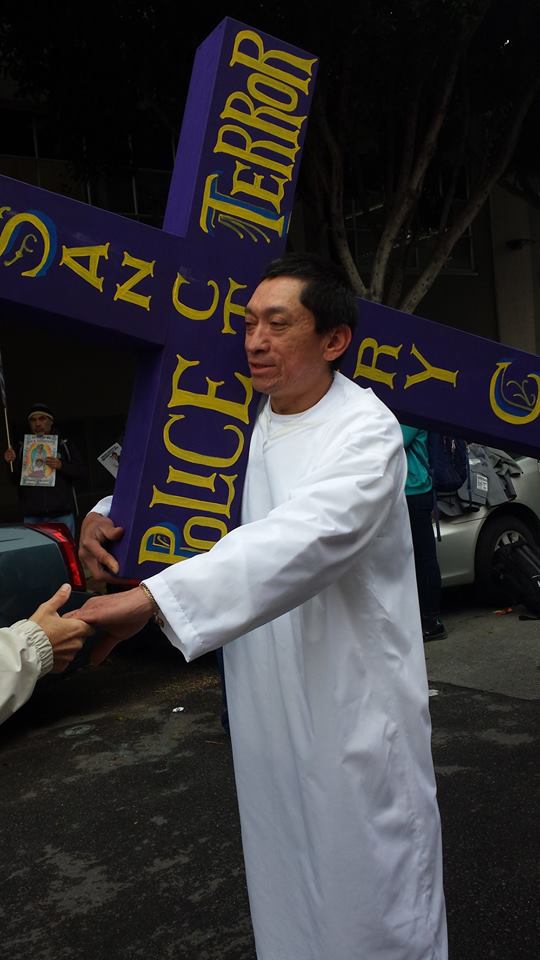Crime
March and Rally in S.F. on Anniversary of Immigrant’s Shooting Death by Police

By Adriana Camarena
Undaunted by the threat of rain, dozens marched and rallied on the anniversary of the death of Luis Gongorra-Pat, an immigrant worker from Yucatan, Mexico, who was shot by San Francisco police on April 7, 2016, at 19th and Shotwell streets.
Cell-phone videos taken by witnesses a year ago show that Gongora-Pat, 45, was shot by four to five bean bag rounds and seven bullets by Officer Michael Mellone and Sergeant Nate Seger in the span of 28 seconds from the moment of their arrival in response to a call that someone at the camp for the homeless was wielding knife. Gongora-Pat, an indigenous Mayan who spoke little Spanish and even less English, was sitting down when police showed up, witnesses said.
Gongora-Pat immigrated to the U.S. in 2004 and worked as a dishwasher among other Mayan Yucatecs at a Mels’ Diner in the Mission. But he would lose that job, and later his housing by 2013 putting him among the homeless in San Francisco.
The altar built in his memory was erected at the site where he was killed. Bernardo Caamal, an expert in Mayan customs from Peté, Yuctaán, led a Ceremoniral Ku’sakai prayer and Ohlone activist Corrina Gould and Danza Azteca were on hand. The march then proceeded to the Mission District police station, where the police who killed Gongorra-Pat worked and then on to the rally at City Hall.
To underscore the suffering of his brother, José Góngora Pat, the brother of Luis, carried a heavy cross from station to station of the protest march, called the March on Police Terror in the anctuary City.”
“My brother’s unjust killing by police is the cross that I have to bear,” said José. He concluded his protest march in honor of Luís by re-enacting his brother’s death at the steps of City Hall, adding “I put myself in his shoes to help the people of San Francisco understand the horror and pain and injustice inflicted on my brother by those officers.”
Gongora-Pat’s cousins Luis and Carlos Poot were also among the marchers.
POOR Magazine’s Tiny Gray-Garcia was the MC of the rally which involved with a large cross- section of supporters, including family members, Causa Justa, Mothers on the March for Justice and homeless advocate organizations.
At City Hall, Adante Pointer, of the John Burris law firm, who represents the family in a federal civil case against SFPD, reminded the crowd that the trial won’t happen until 2018. Carolina Morales, legislative aide to District 9 Supervisor Hillary Ronen and Francisco Ugarte, Immigrant Defense Public Defender of San Francisco also spoke. The rally closed with a poem by Amalia Alvarez in honor of Góngora-Pat.
POOR magazine, and El Tecolote contributed to this report.
Activism
Oakland Post: Week of December 24 – 30, 2025
The printed Weekly Edition of the Oakland Post: Week of – December 24 – 30, 2025

To enlarge your view of this issue, use the slider, magnifying glass icon or full page icon in the lower right corner of the browser window.
Alameda County
Oakland Council Expands Citywide Security Cameras Despite Major Opposition
In a 7-1 vote in favor of the contract, with only District 3 Councilmember Carroll Fife voting no, the Council agreed to maintain its existing network of 291 cameras and add 40 new “pan-tilt-zoom cameras.”

By Post Staff
The Oakland City Council this week approved a $2.25 million contract with Flock Safety for a mass surveillance network of hundreds of security cameras to track vehicles in the city.
In a 7-1 vote in favor of the contract, with only District 3 Councilmember Carroll Fife voting no, the Council agreed to maintain its existing network of 291 cameras and add 40 new “pan-tilt-zoom cameras.”
In recent weeks hundreds of local residents have spoken against the camera system, raising concerns that data will be shared with immigration authorities and other federal agencies at a time when mass surveillance is growing across the country with little regard for individual rights.
The Flock network, supported by the Oakland Police Department, has the backing of residents and councilmembers who see it as an important tool to protect public safety.
“This system makes the Department more efficient as it allows for information related to disruptive/violent criminal activities to be captured … and allows for precise and focused enforcement,” OPD wrote in its proposal to City Council.
According to OPD, police made 232 arrests using data from Flock cameras between July 2024 and November of this year.
Based on the data, police say they recovered 68 guns, and utilizing the countywide system, they have found 1,100 stolen vehicles.
However, Flock’s cameras cast a wide net. The company’s cameras in Oakland last month captured license plate numbers and other information from about 1.4 million vehicles.
Speaking at Tuesday’s Council meeting, Fife was critical of her colleagues for signing a contract with a company that has been in the national spotlight for sharing data with federal agencies.
Flock’s cameras – which are automated license plate readers – have been used in tracking people who have had abortions, monitoring protesters, and aiding in deportation roundups.
“I don’t know how we get up and have several press conferences talking about how we are supportive of a sanctuary city status but then use a vendor that has been shown to have a direct relationship with (the U.S.) Border Control,” she said. “It doesn’t make sense to me.”
Several councilmembers who voted in favor of the contract said they supported the deal as long as some safeguards were written into the Council’s resolution.
“We’re not aiming for perfection,” said District 1 Councilmember Zac Unger. “This is not Orwellian facial recognition technology — that’s prohibited in Oakland. The road forward here is to add as many amendments as we can.”
Amendments passed by the Council prohibit OPD from sharing camera data with any other agencies for the purpose of “criminalizing reproductive or gender affirming healthcare” or for federal immigration enforcement. California state law also prohibits the sharing of license plate reader data with the federal government, and because Oakland’s sanctuary city status, OPD is not allowed to cooperate with immigration authorities.
A former member of Oakland’s Privacy Advisory Commission has sued OPD, alleging that it has violated its own rules around data sharing.
So far, OPD has shared Flock data with 50 other law enforcement agencies.
Activism
Oakland Post: Week of December 17 – 23, 2025
The printed Weekly Edition of the Oakland Post: Week of – December 17 – 23, 2025

To enlarge your view of this issue, use the slider, magnifying glass icon or full page icon in the lower right corner of the browser window.
-

 #NNPA BlackPress4 weeks ago
#NNPA BlackPress4 weeks agoLIHEAP Funds Released After Weeks of Delay as States and the District Rush to Protect Households from the Cold
-

 Alameda County4 weeks ago
Alameda County4 weeks agoSeth Curry Makes Impressive Debut with the Golden State Warriors
-

 #NNPA BlackPress4 weeks ago
#NNPA BlackPress4 weeks agoSeven Steps to Help Your Child Build Meaningful Connections
-

 #NNPA BlackPress4 weeks ago
#NNPA BlackPress4 weeks agoSeven Steps to Help Your Child Build Meaningful Connections
-

 #NNPA BlackPress4 weeks ago
#NNPA BlackPress4 weeks agoTrinidad and Tobago – Prime Minister Confirms U.S. Marines Working on Tobago Radar System
-

 #NNPA BlackPress4 weeks ago
#NNPA BlackPress4 weeks agoThanksgiving Celebrated Across the Tri-State
-

 #NNPA BlackPress4 weeks ago
#NNPA BlackPress4 weeks agoTeens Reject Today’s News as Trump Intensifies His Assault on the Press
-

 #NNPA BlackPress4 weeks ago
#NNPA BlackPress4 weeks agoBreaking the Silence: Black Veterans Speak Out on PTSD and the Path to Recovery






















































